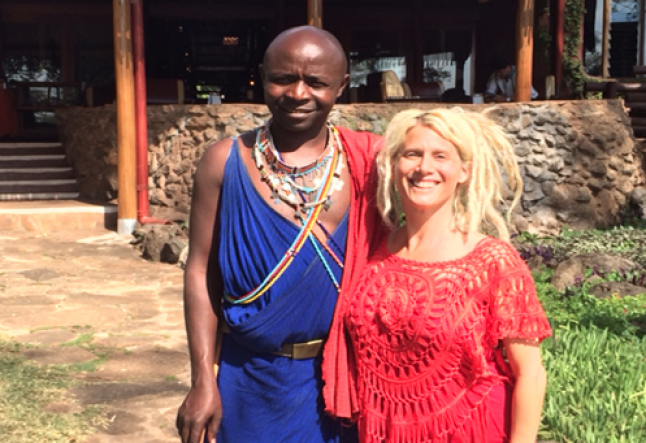from the bhakti trail ….africa

the masai & me
In the words of Madonna”¦“Music Makes the People Come Together, Yeah!”
This has never felt truer to me than while in Africa. In Kenya there are 42 native tribes which speak their mother tongue and in Tanzania, 125. This is in addition to the national language of Swahili and English, which most natives speak in Kenya and 25% of the population in Tanzania.
The Masai people inhabit both countries and speak Ma or Masai. They are an ancient tribe commonly seen clad in colorful beads draped around the neck, ankles, waist and head. The men wear mostly red, blue and yellow-checkered fabrics wrapped in a toga like-style. The women are clothed in a multitude of indigenous African scarves. They are worn around their waist, shoulders and back— often with babies tied onboard.
The Masai tiny, single room, dung houses are divided into 3 parts. One corner has a bed for the children. One corner has a bed for the parents. The front area is for their small cows, which sleep with them. There is virtually no light inside. There is no electricity. There is no plumbing. There is a mere a 4×4 inch “window/hole” which allows the smoke from their fire (stove) to escape. Their diet consists of raw goat, sheep and cow meat, raw milk, and, wait for it…raw blood. No vegetables. No fruit. No bread. Suffice it to say its primitive, incredibly foreign and a world away from New York City.
The Masai Village visit with my family began with a welcome dance. There was chanting and impressive jumping by the men. The belief is the higher they jump, the more women they will likely attract. Incidentally, Masai men are polygamists. There were no instruments used in this ritual other than their voices. A cacophony of humming and rhythmic chanting simultaneously felt haunting and ecstatic. Most importantly and interesting however, it felt Inviting. We jumped. We droned. We JOINED in. “Music makes the people come together…Yeah!” After the men welcomed us the woman sang. Here again inviting us to join in by replacing the barriers of the unfamiliar with familiar heartfelt song.
Inspired by the visit I began writing a new song. Half the song would be in Swahili and the other half, Masai. We stayed in many different safari tented campsites. In Amboseli (Kenya), I had the pleasure of befriending a Masai worker, Simone. Eager to help Simone and I translated the lyrics from English into Masai. With the use of my all-purpose iPhone we recorded proper pronunciation and translation. In the moments of creating all the aforementioned information about Masai vanished. Simone’s bedazzled blue blanket dress, and the initiation circular burns on the cheeks of his face no longer took my attention. It was his soul and mine making music and joyfully connecting to something bigger than our differences. We were celebrating the Oneness of the human spirit.
Thank you-ashe oleng
Thank you God- ashe oleng enkai ai
Thank you for the earth-ashe oleng engop
Thank you for the animals-ashe oleng ingwesi
Thank you for the water -ashe oleng engarre
“Music makes the people come together. Music Makes the bourgeoisie & the rebel.”- Madonna
Read next >> the same pond